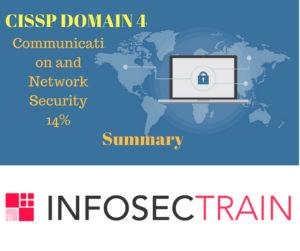Domain 4: Communication And Network Security (Weightage 14%)

Communications and Network Security is one of the largest domains and focuses on the confidentiality, integrity, and availability of data in motion. This domain discusses about various communication protocols such as simplex, half- duplex and full – duplex, also about LANs, WANs, MANs, GANs, and PANs.
Next, it covers the most important aspect of Networking the OSI (open system interconnection) model, which has 7 layers Physical, Data Link, Network, Transport, Session, Presentation, and Application and the TCP/IP model consisting of Network Access, Internet, Host-to-Host transport, Application. It covers various protocols such as TCP, UDP, ICMP, Telnet, FTP, SSH, SMTP, DNS, HTTP, HTTPS, POP, IMAP.
Next it covers Software-defined networking (SDN) which separates a router’s control plane from the data (forwarding) plane. The most well-known protocol in this space is OpenFlow, which can, among other capabilities, allow for control of switching rules to be designated or updated at a central controller. OpenFlow is a TCP protocol that uses transport layer security (TLS) encryption. The most common form of wireless data networking is the 802.11 wireless standard.
Frequency-hopping spread spectrum (FHSS) and direct-sequence spread spectrum (DSSS) are two methods for sending traffic via a radio band. The WEP is the wired equivalent privacy protocol was an early attempt (first ratified in 1999) to provide 802.11 wireless security.
It discusses about repeaters, hubs, bridges, switches, VLANs, routers, firewalls, proxy firewalls, Modem. An authentication protocol authenticates an identity claim over the network.Good security design assumes that a network eavesdropper may sniff all packets sent between the client and authentication server, so the protocol should remain secure.
It also covers VPN, PPP, IPSec, SSL and TLS. Remote access plays an important role in digitalization that includes methods like DSL, Cable modems, Remote desktops, Screen Scraping, Instant messaging, PDAs.






 1800-843-7890 (India)
1800-843-7890 (India)